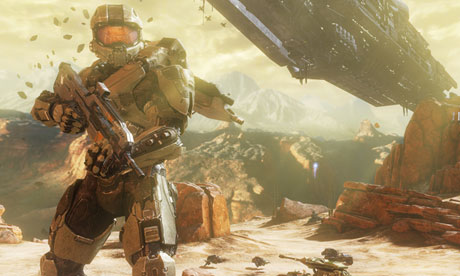
There's something almost nostalgic about Halo 4 (Xbox 360). It is 11 years since the galaxy-trotting saga began with the defining flagship title of the original Xbox, Halo: Combat Evolved, and since then, true to its name, the franchise has progressed at a Darwinian pace.
It's not that nothing has ever been added. Quite the opposite: new guns, vehicles, aliens and allies have all leapt into the fray with each new release. Halo 2 was the first to let players dual-wield rifles, and it wasn't until Halo 3 that players locked horns with hulking, four-legged walking tanks. But it's in no way a criticism to say that, at core, the experience of playing a Halo game is, like the shark, almost entirely unevolved since that first perfect killer.
Much of Halo 4's multiplayer mode – or "Infinity mode", as it has been inexplicably rechristened – will be fondly familiar to past players. There's the usual broad range of maps, mixing sprawling vehicle-laden badlands with hovering, hi-tech fortresses full of air-lifts, balconies and sheer drops, and the usual array of weapons, including energy swords and sniper rifles, plus a couple of funky new additions. And while there are new vehicles in the campaign, Infinity focuses on the classics: the Warthog buggy, the alien hover-bike, the Ghost and a quaintly useless unarmed quad bike, the Mongoose.
The most notable change is a new focus on unlockables. Previous titles featured levels and ranks, but kept them out of the combat experience itself. No longer. In Halo 4, players gain levels – or Spartan Ranks – that allow them to unlock new starting weapons load-outs, switching, for example, their battle rifle for an assault rifle, or their frag grenades for plasmas. It's the same system employed in most other modern first-person shooters, but in a Halo game, where the best weapons are drastically more powerful than the worst, there's a risk it will feel a little unfair. You know, on the n00bs.
There is also a risk that the introduction of kill-streak rewards will prove demoralising for lesser players. Those who manage to rack up a chain of kills can now have weapons and power-ups delivered right to their feet, making it harder than ever to overturn a deficit, and easier for a single elite player to run riot. Of course, it's always fun if that elite player happens to be you. But less so if you're the guy he's one-shot killed the last 10 times.
The playing field may be less level, but the sport has hardly changed. You'll still find yourself scrambling, at the start of each game, to get hold of the best guns and vehicles, or else spend much of the rest of it being killed by better-armed opponents. Likewise, when you come face-to-face with the other team, jumping will still be your best friend, and shooting someone leaping directly over you remains one of the game's core skills, as does running directly at the other guy and braining them with a well-timed rifle slap.
Spartan Ops – the game's co-operative missions – promise something a bit different. Released in seasons of 50 missions, five a week for 10 weeks, they come with accompanying introductory cinematics supplementing the main story, and can be played alone or alongside up to three allies over Xbox Live. Coupled with a full offline campaign, there's clearly plenty here for gamers who prefer to avoid the cut, thrust and frequent tea-bagging of player-versus-player. (If you don't know, don't look it up.)
The campaign itself sees original hero Master Chief awake after four years cryo-sleep to an alien assault, and begins in archetypal Halo fashion. Minutes in, trusty AI sidekick Cortana is barking at our hero to reach an air-lock before the ship they are on explodes. Soon after, panicked alien grunts are scurrying away like quacking, punch-drunk toddlers, and soon after that the Chief is racing across the surface of an unknown planet in a handy buggy. The graphics are better, the cut-scenes stunning, but the game itself looks like Halo as usual.
I have not had enough time with the game to encounter the freaky robot dogs, clanking necro-droids and other new evils that I know from trailers the campaign has in store, but it's unlikely their arrival will send the game veering off in a whole new direction. This looks like a sequel fiercely loyal to its predecessors, with enough courage to add a few new tricks, and enough sense not to tinker with the bits that ain't broke. If it's Halo as usual, that's no bad thing at all.

